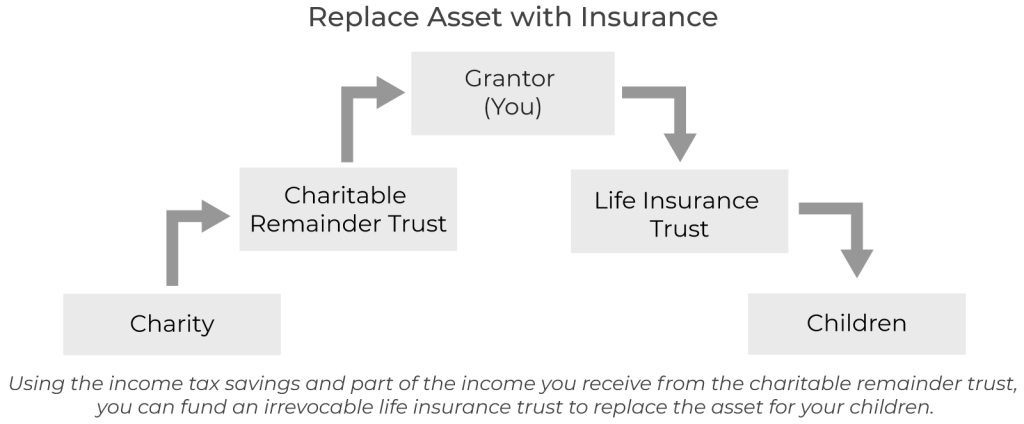
How to Secure a Lifetime Income, Save Taxes, and Benefit a Charity
Since 1969, countless families have used charitable remainder trusts (CRTs) to increase their income, save taxes, and benefit charities.
What does a CRT do?
A CRT lets you convert a highly appreciated asset like stock or real estate into lifetime income. It reduces your income taxes now and estate taxes when you die. You pay no capital gains tax when the asset is sold. It also lets you help one or more charities that have special meaning to you.
How does a CRT work?
You transfer an appreciated asset into an irrevocable trust. This removes the asset from your estate, so no estate taxes will be due on it when you die. You also receive an immediate charitable income tax deduction.
The trustee then sells the asset at full market value, paying no capital gains tax, and reinvests the proceeds in income-producing assets. For the rest of your life, the trust pays you an income. When you die, the remaining trust assets go to the charities you have chosen. That is why it is called a charitable remainder trust.
Why not sell the asset myself and reinvest?
You could, but you would pay more in taxes, and there would be less income for you. Consider the following example.
Years ago, Max and Jane Brody (ages sixty-five and sixty-three) purchased some stock for $100,000. It is now worth $500,000. They would like to sell it and generate some retirement income.
If they sell the stock, they would have a gain of $400,000 (current value less cost) and would have to pay $60,000 in federal capital gains tax (15 percent capital gains rate applied to the $400,000 gain). That would leave them with $440,000. (See chart below.)
If they reinvest and earn a 5 percent return, that would provide them with $22,000 in annual income. Multiplied by their life expectancy of twenty-six years, this would give them a total lifetime income (before taxes) of $572,000. Because they still own the assets, there is no protection from creditors, and no charitable income tax deduction is available.
What happens if they use a CRT?
If they transfer the stock to a CRT instead, the Brodys can take an immediate charitable income tax deduction of approximately $160,000. Because they are in a 35 percent tax bracket, this will reduce their current federal income taxes by $56,000.
The trustee will sell the stock for the same amount (see chart below), but because the trust is exempt from capital gains tax, the full $500,000 is available to reinvest. The same 5 percent return will produce $25,000 in annual income which, before taxes, will total $650,000 over their lifetimes. That is $78,000 more in income than if the Brodys had sold the stock themselves. Further, because the assets are in an irrevocable trust, they are protected from creditors.
What are my income choices?
You can receive a fixed percentage of the trust assets (like the Brodys), in which case your trust would be called a charitable remainder unitrust. With this option, the amount of your annual income will fluctuate, depending on investment performance and the annual value of the trust.
The trust will be revalued at the beginning of each year to determine the dollar amount of income you will receive. If the trust is well managed, it can grow quickly because the trust assets grow tax-free. The amount of your income will increase as the value of the trust grows.
Sometimes the assets contributed to the trust, like real estate or stock in a closely held corporation, are not readily marketable, so income is difficult to pay. In that case, the trust can be designed to pay the lesser of the fixed percentage of the trust’s assets or the actual income earned by the trust. A provision is usually included so that if the trust has an off year, it can make up any loss of income in a better year.
Can I receive a fixed income instead?
Yes. You can elect instead to receive a fixed income, in which case the trust would be called a charitable remainder annuity trust. This means that, regardless of the trust’s performance, your income will not change.
This option is usually a good choice at older ages. It does not provide protection against inflation like a unitrust does, but some people like the security of being able to count on a definite amount of income each year. It is best to use cash or readily marketable assets to fund an annuity trust.
In either type of CRT (unitrust or annuity trust), the Internal Revenue Service (IRS) requires that the payout rate stated in the trust cannot be less than 5 percent or more than 50 percent of the initial fair market value of the trust’s assets.
Who can receive income from the trust?
Trust income, which is generally taxable in the year it is received, can be paid to you for your lifetime. If you are married, it can be paid for as long as either of you lives.
The income can also be paid to your children for their lifetimes or to any other person or entity you wish, provided that the trust meets certain requirements. In addition, there are gift and estate tax considerations if someone other than you receives it. Instead of lasting for someone’s lifetime, the trust can also exist for a set number of years (up to twenty).
Do I have to take the income now?
No. You can set up the trust and take the income tax deduction now but postpone taking the income until later. By then, with good management, the trust assets will have appreciated considerably in value, resulting in more income for you.
How is the income tax deduction determined?
The deduction is based on the amount of income received, the type and value of the asset, the ages of the people receiving the income, and the Section 7520 interest rate, which fluctuates. You can click this link to find the latest Section 7520 interest rates. Generally, the higher the payout rate, the lower the deduction.
The income tax deduction is usually limited to 30 percent of adjusted gross income, but it can vary from 20 percent to 60 percent, depending on how the IRS defines the charity and the type of asset. If you cannot use the full deduction the first year, you can carry it forward for up to five additional years. Depending on your tax bracket, the type of asset, and the type of charity, the charitable deduction can reduce your income taxes by 10 percent, 20 percent, 30 percent, or even more.
Under the Coronavirus Aid, Relief, and Economic Security (CARES) Act, you can deduct up to 100 percent of your charitable cash contributions to qualifying charities made in the 2020 calendar year. You can find more information regarding this temporary benefit by visiting this web page.
What kinds of assets are suitable?
The best assets are those that have greatly appreciated in value since you purchased them, specifically publicly traded securities, real estate, and stock in some closely held corporations. (S corporation stock does not qualify. Mortgaged real estate usually will not qualify, either, but you might consider paying off the loan.) Cash can also be used.
Who should be the trustee?
You can be your own trustee. But you must be sure that the trust is administered properly—otherwise, you could lose the tax advantages or be penalized. Most people who name themselves as trustee have the paperwork handled by a qualified third party administrator.
However, because experience with investments, accounting, and government reporting is required, some people select a corporate trustee (a bank or trust company that specializes in managing trust assets) as trustee. Some charities are also willing to be trustees.
Before naming a trustee, it is a good idea to interview several candidates and consider their investment performance, services, and experience with these trusts. Remember, you are depending on the trustee to manage your trust properly and to provide you with income.
Do I still have some control?
Yes. For as long as you live, the trustee you select—not the charity—controls the assets. Your trustee must follow the instructions you put in your trust. You can retain the right to change the trustee if you become dissatisfied. You can also change the charity (to another qualified charity) without losing the tax advantages.
Can I make any other changes?
Generally, once an irrevocable trust is signed, you cannot make any other changes. Be sure you understand the entire document and that it is exactly what you want before you sign.
Sounds great for me. But if I give away the asset, what about my children?
If you have a sizable estate, the asset you place in a CRT may only be a small percentage of your assets, so your children may be well taken care of. However, if you are concerned about replacing the value of this asset for your children, there is an easy way to do so.
As the illustration below shows, using the income tax savings and part of the income you receive from the charitable remainder trust, you can fund an irrevocable life insurance trust. The trustee of the insurance trust can then purchase enough life insurance to replace the full value of the asset for your children or other beneficiaries.
Why use a life insurance trust?
With a trust, the insurance proceeds will not be included in your estate, so you avoid estate taxes. You can keep the proceeds in the trust for years, making periodic distributions to your children and grandchildren. And any proceeds that remain in the trust are protected from irresponsible spending and creditors (even spouses).
Life insurance can be an inexpensive way to replace the asset for your children. (Every dollar you spend in premium buys several dollars of insurance.) Insurance proceeds are available immediately, even if you and your spouse both die tomorrow. Further, in addition to avoiding estate taxes, the proceeds will be free from probate and income taxes.
So what is the catch?
There really is no catch. Combining a charitable remainder trust with an irrevocable life insurance trust is a winning formula for everyone—you, your children, and the charity.
You convert an appreciated asset into lifetime income, and because you pay no capital gains tax when the asset is sold, you receive more income than if you had sold it yourself and invested the sales proceeds. You receive an immediate charitable income tax deduction, reducing your current income taxes. And by removing the asset from your estate, you reduce estate taxes that may be due when you die.
With the life insurance trust replacing the full value of the asset, your children receive much more than if you had sold the asset yourself and paid capital gains and estate taxes. The proceeds are also free of income and estate taxes, as well as probate.
Finally, you will make a substantial gift to a favorite charity. Because the charity knows it will receive the gift at some point in the future, it can plan projects and programs now—benefiting even before receiving the gift.
Should I seek professional assistance?
Yes. If you think a charitable remainder trust would be of value to you and your family, speak with an estate planning attorney, insurance professional, corporate trustee, investment adviser, CPA, or your favorite charity. Be sure an attorney experienced in CRTs prepares the documents.
Benefits of a Charitable Remainder Trust
- Convert an appreciated asset into lifetime income
- Reduce your current income taxes with charitable income tax deduction
- Pay no capital gains tax when the asset is sold
- Reduce or eliminate your estate taxes
- Gain protection from creditors for the gifted asset
- Benefit one or more charities
- Receive more income over your lifetime than if you had sold the asset yourself
- Leave more to your children or others by using a life insurance trust to replace the gifted asset
The Second Estate can help you make the best use of a range of trusts and other financial programs to protect your hard-earned money. Schedule a free appointment now to get started!
Why not sell the asset myself and reinvest?
You could, but you would pay more in taxes, and there would be less income for you. Consider the following example.
Years ago, Max and Jane Brody (ages sixty-five and sixty-three) purchased some stock for $100,000. It is now worth $500,000. They would like to sell it and generate some retirement income.
If they sell the stock, they would have a gain of $400,000 (current value less cost) and would have to pay $60,000 in federal capital gains tax (15 percent capital gains rate applied to the $400,000 gain). That would leave them with $440,000. (See chart below.)
If they reinvest and earn a 5 percent return, that would provide them with $22,000 in annual income. Multiplied by their life expectancy of twenty-six years, this would give them a total lifetime income (before taxes) of $572,000. Because they still own the assets, there is no protection from creditors, and no charitable income tax deduction is available.
What happens if they use a CRT?
If they transfer the stock to a CRT instead, the Brodys can take an immediate charitable income tax deduction of approximately $160,000. Because they are in a 35 percent tax bracket, this will reduce their current federal income taxes by $56,000.
The trustee will sell the stock for the same amount (see chart below), but because the trust is exempt from capital gains tax, the full $500,000 is available to reinvest. The same 5 percent return will produce $25,000 in annual income which, before taxes, will total $650,000 over their lifetimes. That is $78,000 more in income than if the Brodys had sold the stock themselves. Further, because the assets are in an irrevocable trust, they are protected from creditors.
What are my income choices?
You can receive a fixed percentage of the trust assets (like the Brodys), in which case your trust would be called a charitable remainder unitrust. With this option, the amount of your annual income will fluctuate, depending on investment performance and the annual value of the trust.
The trust will be revalued at the beginning of each year to determine the dollar amount of income you will receive. If the trust is well managed, it can grow quickly because the trust assets grow tax-free. The amount of your income will increase as the value of the trust grows.
Sometimes the assets contributed to the trust, like real estate or stock in a closely held corporation, are not readily marketable, so income is difficult to pay. In that case, the trust can be designed to pay the lesser of the fixed percentage of the trust’s assets or the actual income earned by the trust. A provision is usually included so that if the trust has an off year, it can make up any loss of income in a better year.
Can I receive a fixed income instead?
Yes. You can elect instead to receive a fixed income, in which case the trust would be called a charitable remainder annuity trust. This means that, regardless of the trust’s performance, your income will not change.
This option is usually a good choice at older ages. It does not provide protection against inflation like a unitrust does, but some people like the security of being able to count on a definite amount of income each year. It is best to use cash or readily marketable assets to fund an annuity trust.
In either type of CRT (unitrust or annuity trust), the Internal Revenue Service (IRS) requires that the payout rate stated in the trust cannot be less than 5 percent or more than 50 percent of the initial fair market value of the trust’s assets.
Who can receive income from the trust?
Trust income, which is generally taxable in the year it is received, can be paid to you for your lifetime. If you are married, it can be paid for as long as either of you lives.
The income can also be paid to your children for their lifetimes or to any other person or entity you wish, provided that the trust meets certain requirements. In addition, there are gift and estate tax considerations if someone other than you receives it. Instead of lasting for someone’s lifetime, the trust can also exist for a set number of years (up to twenty).
Do I have to take the income now?
No. You can set up the trust and take the income tax deduction now but postpone taking the income until later. By then, with good management, the trust assets will have appreciated considerably in value, resulting in more income for you.
How is the income tax deduction determined?
The deduction is based on the amount of income received, the type and value of the asset, the ages of the people receiving the income, and the Section 7520 interest rate, which fluctuates. You can click this link to find the latest Section 7520 interest rates. Generally, the higher the payout rate, the lower the deduction.
The income tax deduction is usually limited to 30 percent of adjusted gross income, but it can vary from 20 percent to 60 percent, depending on how the IRS defines the charity and the type of asset. If you cannot use the full deduction the first year, you can carry it forward for up to five additional years. Depending on your tax bracket, the type of asset, and the type of charity, the charitable deduction can reduce your income taxes by 10 percent, 20 percent, 30 percent, or even more.
Under the Coronavirus Aid, Relief, and Economic Security (CARES) Act, you can deduct up to 100 percent of your charitable cash contributions to qualifying charities made in the 2020 calendar year. You can find more information regarding this temporary benefit by visiting this web page.
What kinds of assets are suitable?
The best assets are those that have greatly appreciated in value since you purchased them, specifically publicly traded securities, real estate, and stock in some closely held corporations. (S corporation stock does not qualify. Mortgaged real estate usually will not qualify, either, but you might consider paying off the loan.) Cash can also be used.
Who should be the trustee?
You can be your own trustee. But you must be sure that the trust is administered properly—otherwise, you could lose the tax advantages or be penalized. Most people who name themselves as trustee have the paperwork handled by a qualified third party administrator.
However, because experience with investments, accounting, and government reporting is required, some people select a corporate trustee (a bank or trust company that specializes in managing trust assets) as trustee. Some charities are also willing to be trustees.
Before naming a trustee, it is a good idea to interview several candidates and consider their investment performance, services, and experience with these trusts. Remember, you are depending on the trustee to manage your trust properly and to provide you with income.
Do I still have some control?
Yes. For as long as you live, the trustee you select—not the charity—controls the assets. Your trustee must follow the instructions you put in your trust. You can retain the right to change the trustee if you become dissatisfied. You can also change the charity (to another qualified charity) without losing the tax advantages.
Can I make any other changes?
Generally, once an irrevocable trust is signed, you cannot make any other changes. Be sure you understand the entire document and that it is exactly what you want before you sign.
Sounds great for me. But if I give away the asset, what about my children?
If you have a sizable estate, the asset you place in a CRT may only be a small percentage of your assets, so your children may be well taken care of. However, if you are concerned about replacing the value of this asset for your children, there is an easy way to do so.
As the illustration below shows, using the income tax savings and part of the income you receive from the charitable remainder trust, you can fund an irrevocable life insurance trust. The trustee of the insurance trust can then purchase enough life insurance to replace the full value of the asset for your children or other beneficiaries.
Why use a life insurance trust?
With a trust, the insurance proceeds will not be included in your estate, so you avoid estate taxes. You can keep the proceeds in the trust for years, making periodic distributions to your children and grandchildren. And any proceeds that remain in the trust are protected from irresponsible spending and creditors (even spouses).
Life insurance can be an inexpensive way to replace the asset for your children. (Every dollar you spend in premium buys several dollars of insurance.) Insurance proceeds are available immediately, even if you and your spouse both die tomorrow. Further, in addition to avoiding estate taxes, the proceeds will be free from probate and income taxes.
So what is the catch?
There really is no catch. Combining a charitable remainder trust with an irrevocable life insurance trust is a winning formula for everyone—you, your children, and the charity.
You convert an appreciated asset into lifetime income, and because you pay no capital gains tax when the asset is sold, you receive more income than if you had sold it yourself and invested the sales proceeds. You receive an immediate charitable income tax deduction, reducing your current income taxes. And by removing the asset from your estate, you reduce estate taxes that may be due when you die.
With the life insurance trust replacing the full value of the asset, your children receive much more than if you had sold the asset yourself and paid capital gains and estate taxes. The proceeds are also free of income and estate taxes, as well as probate.
Finally, you will make a substantial gift to a favorite charity. Because the charity knows it will receive the gift at some point in the future, it can plan projects and programs now—benefiting even before receiving the gift.
Should I seek professional assistance?
Yes. If you think a charitable remainder trust would be of value to you and your family, speak with an estate planning attorney, insurance professional, corporate trustee, investment adviser, CPA, or your favorite charity. Be sure an attorney experienced in CRTs prepares the documents.
Benefits of a Charitable Remainder Trust
- Convert an appreciated asset into lifetime income
- Reduce your current income taxes with charitable income tax deduction
- Pay no capital gains tax when the asset is sold
- Reduce or eliminate your estate taxes
- Gain protection from creditors for the gifted asset
- Benefit one or more charities
- Receive more income over your lifetime than if you had sold the asset yourself
- Leave more to your children or others by using a life insurance trust to replace the gifted asset
The Second Estate can help you make the best use of a range of trusts and other financial programs to protect your hard-earned money. Schedule a free appointment now to get started!





